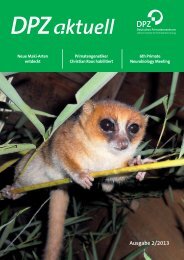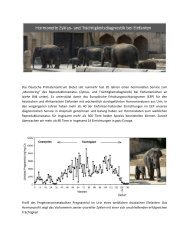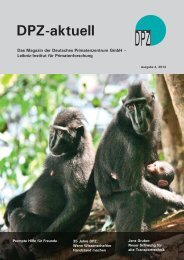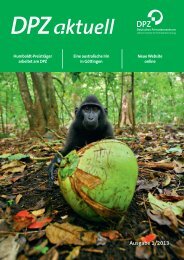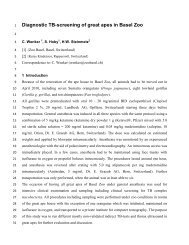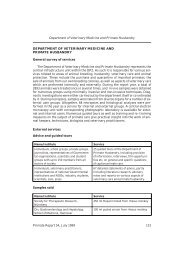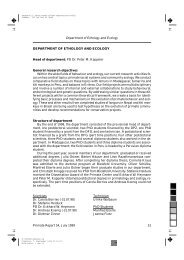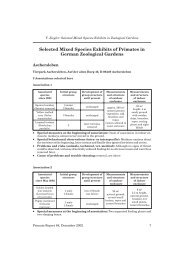Vol. 15 - Deutsches Primatenzentrum
Vol. 15 - Deutsches Primatenzentrum
Vol. 15 - Deutsches Primatenzentrum
Create successful ePaper yourself
Turn your PDF publications into a flip-book with our unique Google optimized e-Paper software.
Lemur News <strong>Vol</strong>. <strong>15</strong>, 2010 Page 71<br />
search, and lemur conservation. Each chapter contains significant<br />
updates from the second edition. The ancient geology<br />
of Madagascar is covered in meticulous detail, while the theories<br />
of lemur origins are explored in depth, leaving both<br />
reader and researcher alike desperate for more definitive<br />
answers.The chapter on the extinct subfossil lemurs is beautifully<br />
illustrated with new peer-reviewed artwork from<br />
award-winning illustrator Stephen D. Nash, and has new details<br />
about their biology and extinction.The history of lemur<br />
research and discovery expands greatly upon the work from<br />
the last half century–a topic greatly underrepresented in the<br />
previous edition. Additionally, the chapter is loaded with<br />
newly added artwork from the 1700s and 1800s. The lemur<br />
conservation chapter provides a critical update on the newest<br />
emerging threats faced by lemurs and their habitat,<br />
namely the logging of precious hardwoods and bushmeat<br />
hunting. Additional detail is also provided about other important<br />
threats that received little mention previously, such<br />
as invasive species, cattle-raising, and mining.<br />
The bulk of the book details the description, geographic<br />
range,natural history,conservation status,and best locations<br />
to observe each of the 101 species and subspecies of lemur.<br />
(This total is up from the 71 taxa detailed in the second edition,yet<br />
the authors note that upcoming research may reveal<br />
as many as 110 to 125 lemur taxa!) Each species section<br />
sports a portrait photo, detailed range map, and other photos<br />
to enrich the lavish textual content.Once again,the third<br />
edition sets itself apart from the previous editions with its<br />
encyclopedic coverage of details from the lemur research literature.Species,such<br />
as the silky sifaka (Propithecus candidus),<br />
are discussed in significantly greater detail,bringing everyone<br />
from bright-eyed ecotourists to veteran lemur researcher<br />
up to speed on the latest findings.<br />
The second edition of Lemurs of Madagascar sold out quickly,<br />
leaving shelves empty as early as February 2008. The third<br />
edition is poised to do the same. With a print run of 10,000<br />
copies,nearly two-thirds are already spoken for according to<br />
Jill Lucena.To help promote conservation education in Madagascar,<br />
CI is generously donating 3,000 copies to its partner<br />
in the field,NGO Fanamby.CI hopes that the remaining copies<br />
will spark the public’s interest in Madagascar’s ecological<br />
gems and spur a new wave of ecotourism to bolster conservation<br />
efforts.<br />
Once again, CI has provided an invaluable tool for a diverse<br />
audience, which includes ecotourists, Malagasy tour guides,<br />
students,lemur researchers,and lemur enthusiasts.Although<br />
larger and not quite as portable as its predecessors, the increased<br />
size of the third edition hosts a wealth of enhanced<br />
encyclopedic detail,new and stunning artwork by Stephen D.<br />
Nash, and additional color photos and illustrations. With a<br />
copy of this printing in hand, the only things missing are a<br />
backpack full of supplies and an airline ticket to Madagascar.<br />
So what are you waiting for?<br />
Alex Dunkel<br />
Theses Completed<br />
Blanco,M.B.2010.Reproductive biology of mouse and dwarf<br />
lemurs of eastern Madagascar,with an emphasis on brown<br />
mouse lemurs (Microcebus rufus) at Ranomafana National<br />
Park,a southeastern rainforest.PhD Dissertation.University<br />
of Massachusetts, Amherst.<br />
This dissertation investigates reproductive schedules of<br />
brown mouse lemurs at Ranomafana,using intensive trap-<br />
ping techniques. The reproductive condition of female<br />
mouse lemurs was recorded on the basis of vaginal morphology,vaginal<br />
smears,body mass gain profiles and nipple<br />
development. Testis size was measured in males throughout<br />
the reproductive season. The timing of the first seasonal<br />
estrus was determined in frequently captured females<br />
over multiple years and it showed individual periodicities<br />
close to 365 days,consistent with endogenous regulation<br />
and entrainment by photoperiod. The timing of<br />
estrus did not correlate with female age or body mass.<br />
Males showed testicular regression during the rainy season,<br />
although there was high inter-individual variation in<br />
testes size at any given point during the reproductive season.<br />
Furthermore, some individuals completed testicular<br />
regression earlier than others. Implications for polyestry<br />
are discussed.<br />
For comparative purposes,mouse lemurs were also trapped<br />
at two study sites in the Tsinjoarivo area: one in a forest<br />
fragment and the other within continuous forest.<br />
These forests are higher in altitude than the main study<br />
area at Ranomafana. Trapping success for mouse lemurs<br />
was lower at Tsinjoarivo than Ranomafana.Albeit preliminary,<br />
data from Tsinjoarivo suggest that females have lower<br />
reproductive success than do females at Ranomafana.<br />
Nevertheless, mouse lemurs in the Tsinjoarivo forest<br />
fragment did not appear to be in "poorer" condition than<br />
those in the continuous forest.It had been reported in the<br />
literature that western gray mouse lemurs captured in secondary<br />
forests have lower body masses and lower recapture<br />
rates than those captured in primary forest; in fact,<br />
the opposite was true of the mouse lemurs at Tsinjoarivo.<br />
I additionally collected data on a larger member of the<br />
family Cheirogaleidae, the dwarf lemurs (Cheirogaleus),<br />
which live in sympatry with Microcebus at Ranomafana and<br />
Tsinjoarivo. I analyzed the patterns of growth, development<br />
and reproduction in Cheirogaleus and Microcebus and<br />
compared dwarf and mouse lemurs to other similarlysized<br />
prosimians which do not undergo torpor or hibernation.These<br />
comparisons draw attention to the unusual<br />
reproductive and metabolic strategies employed by cheirogaleids<br />
to cope with Madagascar’s unpredictable environments,<br />
which ultimately define their very unique life<br />
histories.<br />
Key words: Cheirogaleus, Madagascar, Microcebus, Mouse<br />
lemurs, Rainforest, Ranomafana, Reproduction, Tsinjoarivo.<br />
Bonaventure, R.T.A.R. 2010. Ecologie et comportement de<br />
Propithecus verrreauxi dans les zones d’extension de la<br />
Réserve Spéciale de Bezà Mahafaly.Engineer in agronomy,<br />
option Eaux et forêts.Eaux et forêts,Ecole Supérieure des<br />
Sciences Agronomiques de l’Université d’Antananarivo<br />
(ESSA), Madagascar.<br />
The population of Propithecus verreauxi in the special<br />
reserve of Bezà Mahafaly is one of the conservation targets<br />
of the site which is the subject of a long-term follow.<br />
Natural destruction of their habitat and the pressure of<br />
hunting which is exerted on this species outside of the<br />
current reserve are the origin of the sifakas’ decline.With<br />
the park extension project under way, furthering the<br />
knowledge on behavior and ecology of Propithecus verreauxi<br />
in disturbed areas outside the current reserve is essential<br />
for decision-making regarding conservation measures<br />
for this species. Thus,a study of behavior and ecology<br />
of the sifakas was carried out in the extension area of the<br />
special reserve of Bezà Mahafaly in gallery and transition<br />
forest at the end of the dry period. The study was centered<br />
on 3 focal groups including one in the gallery forest<br />
and two in the transition forest. The method of focal animal<br />
sampling was chosen to study their behavior.A floristic<br />
inventory according to the Gentry method, which<br />
includes transects of 2 x 50 m, was carried out to study<br />
the habitat. On the whole, 120h of observations of sifaka<br />
behavior were carried out and 12 transects were walked.<br />
In disturbed areas, the sifakas still consumed preferred<br />
plants.This resulted in a high intake of 2 or 3 easily digestible<br />
plant species while at the same time a large variety of<br />
other species was consumed.Thus,the disturbance of the<br />
sites did not influence food intake of the sifakas.Moreover,





